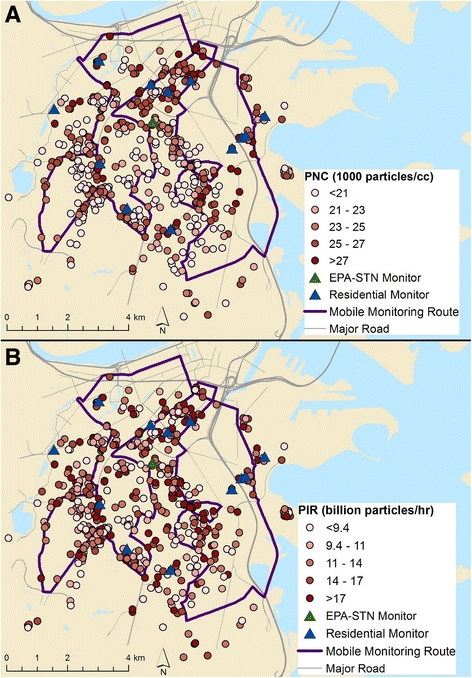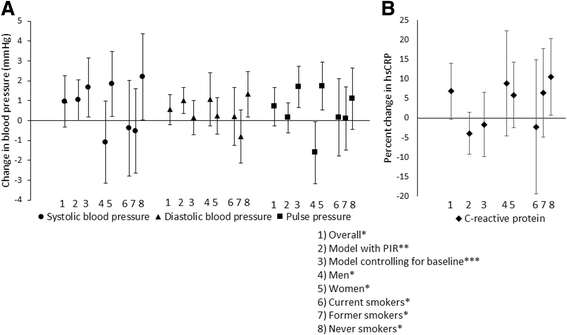Longitudinal associations of long-term exposure to ultrafine particles with blood pressure and systemic inflammation in Puerto Rican adults
- PMID: 29622024
- PMCID: PMC5887259
- DOI: 10.1186/s12940-018-0379-9
Longitudinal associations of long-term exposure to ultrafine particles with blood pressure and systemic inflammation in Puerto Rican adults
Abstract
Background: Few longitudinal studies have examined the association between ultrafine particulate matter (UFP, particles < 0.1 μm aerodynamic diameter) exposure and cardiovascular disease (CVD) risk factors. We used data from 791 adults participating in the longitudinal Boston Puerto Rican Health Study (Massachusetts, USA) between 2004 and 2015 to assess whether UFP exposure was associated with blood pressure and high sensitivity C-reactive protein (hsCRP, a biomarker of systemic inflammation).
Methods: Residential annual average UFP exposure (measured as particle number concentration, PNC) was assigned using a model accounting for spatial and temporal trends. We also adjusted PNC values for participants' inhalation rate to obtain the particle inhalation rate (PIR) as a secondary exposure measure. Multilevel linear models with a random intercept for each participant were used to examine the association of UFP with blood pressure and hsCRP.
Results: Overall, in adjusted models, an inter-quartile range increase in PNC was associated with increased hsCRP (β = 6.8; 95% CI = - 0.3, 14.0%) but not with increased systolic blood pressure (β = 0.96; 95% CI = - 0.33, 2.25 mmHg), pulse pressure (β = 0.70; 95% CI = - 0.27, 1.67 mmHg), or diastolic blood pressure (β = 0.55; 95% CI = - 0.20, 1.30 mmHg). There were generally stronger positive associations among women and never smokers. Among men, there were inverse associations of PNC with systolic blood pressure and pulse pressure. In contrast to the primary findings, an inter-quartile range increase in the PIR was positively associated with systolic blood pressure (β = 1.03; 95% CI = 0.00, 2.06 mmHg) and diastolic blood pressure (β = 1.01; 95% CI = 0.36, 1.66 mmHg), but not with pulse pressure or hsCRP.
Conclusions: We observed that exposure to PNC was associated with increases in measures of CVD risk markers, especially among certain sub-populations. The exploratory PIR exposure metric should be further developed.
Keywords: Blood pressure; C-reactive protein; Exposure assessment; Hispanic; Susceptible populations; Ultrafine particulate matter.
Conflict of interest statement
Ethics approval and consent to participate
This study was approved by the Institutional Review Boards at Tufts Medical Center, Northeastern University (protocol #10–04-12), and the University of Massachusetts Lowell. All participants provided written informed consent.
Consent for publication
Not applicable
Competing interests
The authors declare that they have no competing interests.
Publisher’s Note
Springer Nature remains neutral with regard to jurisdictional claims in published maps and institutional affiliations.
Figures


Similar articles
-
C-reactive protein (CRP) and long-term air pollution with a focus on ultrafine particles.Int J Hyg Environ Health. 2018 Apr;221(3):510-518. doi: 10.1016/j.ijheh.2018.01.016. Epub 2018 Jan 31. Int J Hyg Environ Health. 2018. PMID: 29428699
-
Relationship of Time-Activity-Adjusted Particle Number Concentration with Blood Pressure.Int J Environ Res Public Health. 2018 Sep 18;15(9):2036. doi: 10.3390/ijerph15092036. Int J Environ Res Public Health. 2018. PMID: 30231494 Free PMC article.
-
Association of Long-Term Near-Highway Exposure to Ultrafine Particles with Cardiovascular Diseases, Diabetes and Hypertension.Int J Environ Res Public Health. 2017 Apr 26;14(5):461. doi: 10.3390/ijerph14050461. Int J Environ Res Public Health. 2017. PMID: 28445425 Free PMC article.
-
Impacts of exposure to black carbon, elemental carbon, and ultrafine particles from indoor and outdoor sources on blood pressure in adults: A review of epidemiological evidence.Environ Res. 2018 Feb;161:345-353. doi: 10.1016/j.envres.2017.11.030. Epub 2017 Nov 28. Environ Res. 2018. PMID: 29195183 Review.
-
Health effects of ultrafine particles: a systematic literature review update of epidemiological evidence.Int J Public Health. 2019 May;64(4):547-559. doi: 10.1007/s00038-019-01202-7. Epub 2019 Feb 21. Int J Public Health. 2019. PMID: 30790006
Cited by
-
Air Pollution and Temperature: a Systematic Review of Ubiquitous Environmental Exposures and Sudden Cardiac Death.Curr Environ Health Rep. 2023 Dec;10(4):490-500. doi: 10.1007/s40572-023-00414-7. Epub 2023 Oct 17. Curr Environ Health Rep. 2023. PMID: 37845484 Free PMC article.
-
Development of a Job-Exposure Matrix for Ultrafine Particle Exposure: The MatPUF JEM.Ann Work Expo Health. 2021 Jun 12;65(5):516-527. doi: 10.1093/annweh/wxaa126. Ann Work Expo Health. 2021. PMID: 33637984 Free PMC article. Review.
-
Short-Term and Long-Term Effects of Inhaled Ultrafine Particles on Blood Markers of Cardiovascular Diseases: A Systematic Review and Meta-Analysis.J Clin Med. 2025 Apr 21;14(8):2846. doi: 10.3390/jcm14082846. J Clin Med. 2025. PMID: 40283676 Free PMC article. Review.
-
Exposure to ultrafine particles and cognitive decline among older people in the United States.Environ Res. 2023 Jun 15;227:115768. doi: 10.1016/j.envres.2023.115768. Epub 2023 Mar 24. Environ Res. 2023. PMID: 36965813 Free PMC article.
-
Visualizing Air Pollution: Communication of Environmental Health Information in a Chinese Immigrant Community.J Health Commun. 2019;24(4):339-358. doi: 10.1080/10810730.2019.1597949. Epub 2019 Apr 27. J Health Commun. 2019. PMID: 31030632 Free PMC article.
References
-
- Chuang K-J, Yan Y-H, Chiu S-Y, Cheng T-J. Long-term air pollution exposure and risk factors for cardiovascular diseases among the elderly in Taiwan. Occup Environ Med. 2010;oem.2009.052704. - PubMed
Publication types
MeSH terms
Substances
Grants and funding
LinkOut - more resources
Full Text Sources
Other Literature Sources
Medical
Research Materials

